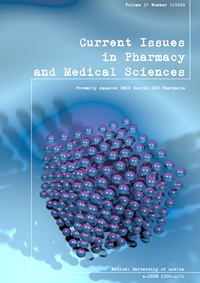Main consequences of enzymatic induction and inhibition during the interaction of drugs and the role of CYP3A4, CYP3A45 enzymes
DOI:
https://doi.org/10.2478/cipms-2024-0001Keywords:
induction, inhibition, enzymes, drugs, toxicityAbstract
The microsomal enzyme system is responsible for the metabolism of pollutants, toxic agents and drugs. With regards to drug metabolism, the activity of the constituent microsomal enzymes results in the reduction of pharmacological and toxicological activity through conversion of hydrophilic (water soluble) compounds to allow urinary excretion. Microsomal enzymes oxidize drugs and steroid hormones in reactions that require adenine nucleotide diphosphate (NADPH). Reversible inhibition reduces enzyme activity through reversible interaction. A covalent bond between the inhibitor and the enzyme can promote the destruction of essential functional groups of the enzyme. Enzyme induction and inhibition are problematic in drug polytherapy. Often the lack of effect of a drug or the side effects that a certain drug exhibits are problems of interaction of drugs with each other in that individually they inhibit or stimulate enzyme activity.References
1. Assad H. Pharmacotherapy prescribing pattern and outcome for hospitalized patients with severe and critical COVID-19.Curr Issues Pharm MedSci. 2022;35(3):106-10.
2. Singh G, Singh R. Objective structured practical examination: A tool design to gauge the perception and performance of the undergraduate medical students for Gram stain.J Med Sci Health.2020;6(2):19-24.
3. Ochyra B, Szewczyk M, Przybylkowski A. The drug safety information in domestic medical literature.Curr Issues Pharm Med Sci.2022;35(3):111-5.
4. Yuliandra Y, Armenia AA, Arief R, Jannah MH, Arifin H. Reversible hepatotoxicity of cassytha filiformis extract: Experimental study on liver function and propofol-induced sleep in mice.Pharmacogn J.2019;11(1):69-74.
5. Karabin T, Biala G, Kruk-Slomka Marta. The recent guidelines for the pharmacotherapy of Parkinson’s Disease.Curr Issues Pharm Med Sci.2022;35(2):80-5.
6. Alshehri M, Wahab A M, Mudawi ME. Drugs-inducing hepatotoxicity.Asian J Pharm Res Heal Care.2020;12(3):148-56.
7. Ziemichod W, Gibula-Tarlowska E, Kotlinska JH, Grochecki P, Kedzierska E. p-Synephrine and its various pharmacological effects.Curr Issues Pharm Med Sci.2021;34(4):169-73.
8. Lee MS, Kim YH, Park WS, Ahn WG, Park OK, Kwon SH, et al. Novel antidepressant-like activity of propolis extract mediated by enhanced glucocorticoid receptor function in the hippocampus.Evid Based Complement Altern Med.2013;2013:217853.
9. Ilkov O, Manko N, Bilous S, Didikin G, Klyuchivska O, Dilay N, Stoika R. Antibacterial and cytotoxic activity of metronidazole and levofloxacin composites with silver nanoparticle.Curr Issues Pharm Med Sci.2021;34(4):224-8.
10. Domazetovic V, Marcucci G, Iantomasi T, Brandi ML, Vincenzini MT. Oxidative stress in bone remodeling: role of antioxidants.Clin Cases Miner Bone Metab.2017;14(2):209.
11. Stych M, Pawlica B. Reverse drug distribution in Poland.Curr Issues Pharm Med Sci.2021;34(3):149-53.
12. Khosla S, Oursler MJ, Monroe DG. Estrogen and the skeleton.Trends Endocrinol Metab.2012;23(11):576-81.
13. Dymek A, Mroczek T. Methods of isolation and bioactivity of alkaloids obtained from selected species belonging to the Amaryllidaceae and Lycopodiaceae families.Curr Issues Pharm Med Sci.2021;34(2):81-6.
14. Peterson B, Weyers M, Steenekamp JH, Steyn JD, Gouws C, Hamman JH. Drug bioavailability enhancing agents of natural origin (bioenhancers) that modulate drug membrane permeation and pre-systemic metabolism.Pharmaceutics.2019;11(1):33.
15. Czarnek K, Siwicki AK. Influence of chromium (III), cobalt (II) and their mixtures on cell metabolic activity.Curr Issues Pharm Med Sci.2021;34(2):87-93.
16. Kim L, McGee L, Tomczyk S, Beall B. Biological and epidemiological features of antibiotic-resistant Streptococcus pneumoniae in preand post-conjugate vaccine eras: A United States perspective.Clin Microbiol Rev.2016;29(3):525-52.
17. Uma KV, Sutheeswaran G, Vineth MJ, Gujadhur M, Moudgil K. An educational review on Probiotics.Curr Issues Pharm Med Sci. 2021;34(2):114-7.
18. The World Health Organization Quality of Life assessment (WHOQOL): position paper from the World Health Organization.Soc Sci Med.1995;41(10):140309.
19. Nizinski P, Wisniewska P, Kulinowska M, and Blazewicz A. Studies on perchlorate levels in powdered infant formulas available on the Polish market.Curr Issues Pharm Med Sci.2021;34(2):94-100.
Downloads
Published
Issue
Section
License
Copyright (c) 2024 Authors

This work is licensed under a Creative Commons Attribution-NonCommercial-NoDerivatives 3.0 Unported License.


